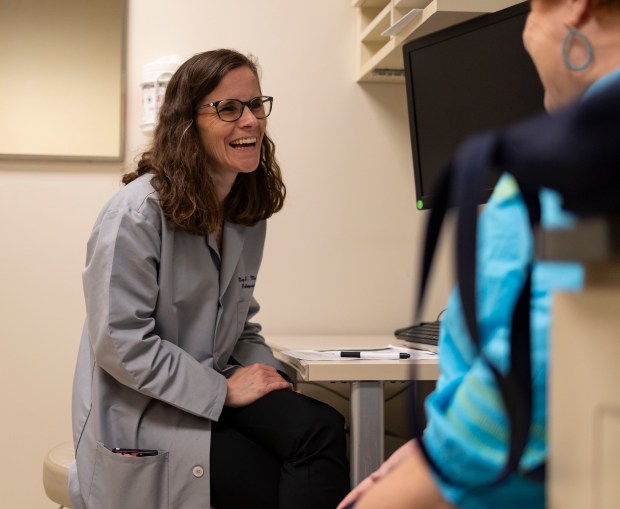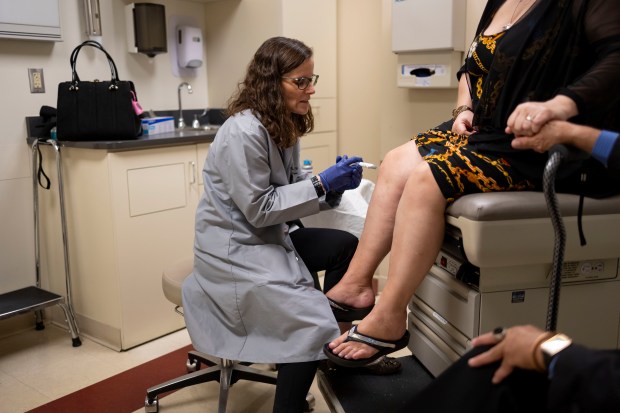When Faith Comas started wrestling in high school, she was one of just two girls on her team. The 18-year-old Cicero teen, who has dreams of wrestling in college, said that often meant everyone supporting her through her sport –– teammates, coaches and trainers –– was male.
“When I got hurt a couple years ago, we had a male physical therapist, and he was really lax about it,” Comas said. “He just told me I’m ‘good to go.’ Having an environment for women would’ve been a lot more comfortable and better for healing the injury long term.”
Dr. Mary Mulcahey, director of sports medicine and an orthopedic surgeon at Loyola Medicine, said stories like Faith’s were what inspired her to help launch a new program to provide health care for female athletes. Loyola’s new Women’s Sports Medicine program aims to educate women on the risks of sports injuries while offering gender-specific care, she said.
“The main impetus or idea behind this is that there are certain injuries that are more common or unique to female athletes, so the program really focuses on having a group that has expertise in treating these conditions and is aware of some of the nuances and differences with treating female athletes,” Mulcahey said.
Mulcahey said that the program will utilize a network of physicians including primary care, sports medicine, orthopedic medicine, endocrinology, urogynecology, sports, cardiology, and obstetrics and gynecology, along with physical therapists and athletic trainers.
The program will allow female athletes to more easily access different kinds of doctors at once, she said. There can be a number of factors that play into an individual injury, according to Mulcahey, and offering a network that can easily connect athletes with several types of doctors eliminates tedious middle steps.
“If I were to see a patient who had a stress factor, for example, I would inquire about their menstrual cycle and their eating habits,” Mulcahey said. “This is a good example of where the interdisciplinary approach really works. If they’re having irregular menses, I could refer them to an OB-GYN colleague. I’d ask about their eating habits, and maybe refer them to a nutritionist or dietician or maybe even a counselor in the program.”
While Mulcahey said it has historically been possible to refer patients to other doctors, the Women’s Sports Medicine program introduces a streamlined approach for female athletes.
The doctors included in the program also all have a particular focus on female patients, she added. Having that specialized knowledge can help in approaching an injury as simple as an ACL tear.
“ACL tears are upwards of eight times more common in female athletes,” Mulcahey said. “In the knee, the ACL is smaller, the overall alignment of the lower extremity of the legs is different in female athletes, hormonal variations and fluctuation throughout the menstrual cycle have a huge impact on the risk of ACL tears. You need doctors that understand that.”
In February, Comas tore her ACL while wrestling and came to Mulcahey for surgery. She said that receiving a treatment specialized for women’s bodies made her feel a lot safer, especially as a wrestler.
Because of a lack of women in her sport, Comas said, she’s often had to wrestle men or women who were in a completely different weight class, presenting a higher risk of injury. Having a doctor who understood how women are built differently from men and could address her symptoms with that in mind made a big difference, she said.
“My freshman year I got injured, and my coach was just asking ‘When can she wrestle? Can she do this?’ Comas said. “I think with this injury things have been explained better and people have been a lot more patient. I can actually focus on healing the injury.”
Giavanna Green, a 17-year-old cheerleader who tore her meniscus and ACL in October, had surgery in May after months of confusion about her injury. Mulcahey also performed Green’s surgery, and Green said she felt supported and encouraged by the network of doctors at Loyola.
Green said that Mulcahey stressed stretching and taking care of her leg, doing proactive exercises to prevent hurting or re-tearing the ligaments. Green said she appreciated that education since things like stretching and taking care of the body can be glossed over in sports, she said
“A lot of people push themselves so hard,” Green said. “If someone came in and taught us to understand how not to overwork ourselves and cause these injuries, I feel like it would be really beneficial.”

Mulcahey said that she plans to do just that in Loyola’s new program. The program aims to partner with local teams, clubs and sports organizations to provide teach-ins and resources on injury prevention for female athletes like Comas and Green.
Getting to women before they are injured is imperative, Mulcahey said.
“We want to connect with and be available for various women’s sports teams,” she said. “We also are looking at giving talks at some of our local high schools where there are many active women and girls, where we could share information about injuries and injury prevention. We’re trying to bring that education into the community.”
Overall, Mulcahey said, the program aims to dig deeper into female injuries, separating outcomes in male and female athletes and learning more about what injuries are more common in or completely unique to female athletes.
“In having a women’s sports medicine program, there is an opportunity to do research to really investigate these injuries in female athletes,” Mulcahey said “Are there differences? Are there things we need to be keeping in mind? Should we be modifying our approach to care for our female athletes? The Women’s Sports Medicine program is an opportunity to do that.”




